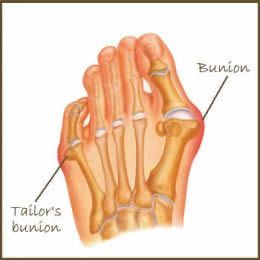About Bunionette Deformity
A bunionette deformity – sometimes referred to as Tailor’s bunion – is a condition which involves the prominence of the fifth metatarsal bone (one of the five long bones which run along the foot) at the little toe’s base. This prominence occurs at the metatarsal head, where the toe meets the bone. Although bunionette deformities, which occur on the outside of the foot, are known to be less common than standard bunions on the inside of the foot, they have similar causes and symptoms.
Causes
A bunionette deformity can be inherited and can be the result of a faulty mechanical foot structure. These changes to the framework of foot bones can be the cause of the enlargement in the fifth metatarsal area. The bone begins to protrude outward, and the little toe pushes inward. The consequence is the creation of a ‘bump’ situated on the outside of the foot, near to the base of the little toe. This, in turn, can cause painful symptoms when a shoe presses or rubs against the protrusion.
A bunionette deformity can also be due to a bone outgrowth (bony spur) on the fifth metatarsal’s side.
Symptoms
Symptoms of bunionette deformity include; swelling, redness and pain at the location of the protrusion. These symptoms can arise when shoes rub against the enlargement, inflaming the area by irritating the soft tissues beneath the skin. It should be noted that symptoms are exacerbated by wearing shoes which are too tight and narrow around the toes, pressuring and rubbing against the enlargement.

Treatment
A physical examination and an x-ray is used to check the extent of the condition and determine its cause.
Non-surgical treatments are available for bunionette deformity, including; padding for shoes, with specially designed bunionette pads being placed over the affected area of the foot; shoe modifications, such as shoes with a wide toe box; icing, using indirect ice application, which can provide fast relief for inflammation and pain; oral medications, including nonsteroidal anti-inflammatory drugs (NSAIDs); injection therapy, which uses corticosteroid to treat inflamed tissue; and orthotic devices, such as custom made inserts which can provided by your doctor or podiatrist.
For cases in which the non-surgical treatments outlined above have proven ineffective or if rapid definitive treatment is needed, surgery can be recommended. The surgical procedure which is recommended will come down to the nature of the individual’s condition, with a foot surgeon taking into account factors such as; x-ray findings, activity level and age.
Surgical procedures used to address bunionette deformity can include; the removal of swollen tissue from the little toe area; the removal of bone in order to straighten the little toe; and the realignment of the metatarsal and the little toe to straighten abnormal angles.
Minimally invasive or keyhole surgery is often very successful in treating bunionettes. Through small 3mm incisions the bone can be divided and repositioned to the correct place and held stable with a small pin. Once healing has completed in 6 weeks the pin can be gently removed without significant pain in clinic, leaving no implants, just a new corrected foot.
As with all foot surgery it is normal for swelling to persists for some months after surgery and is completely normal. This swelling will eventually completely subside with time and can take up to 12 months but often goes well before this.










